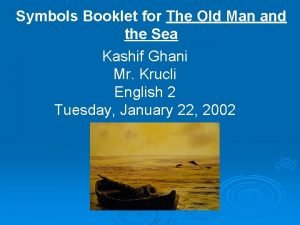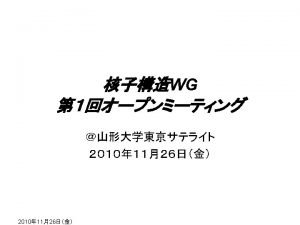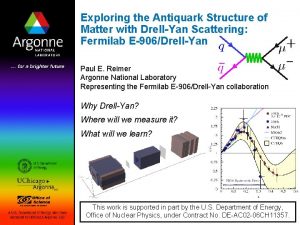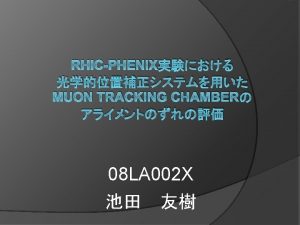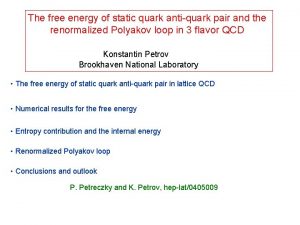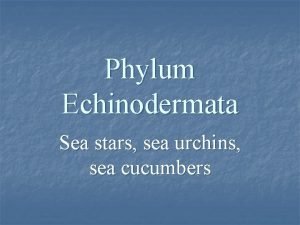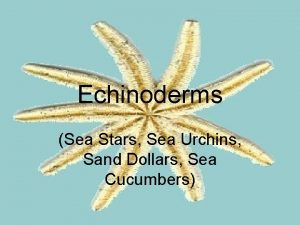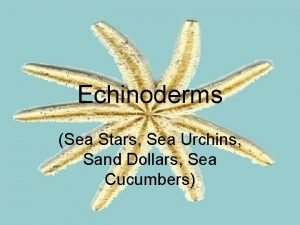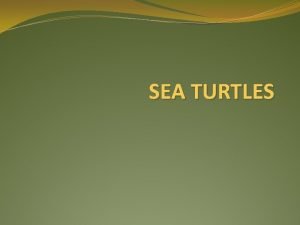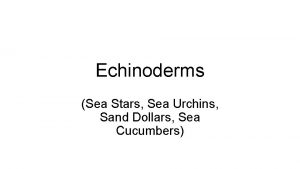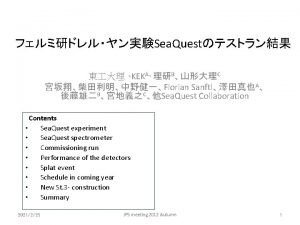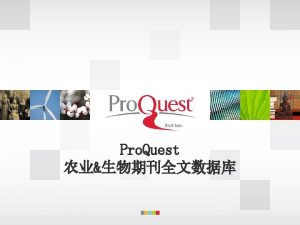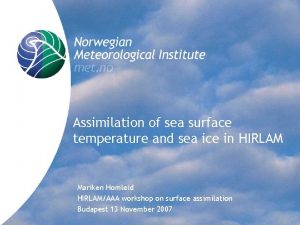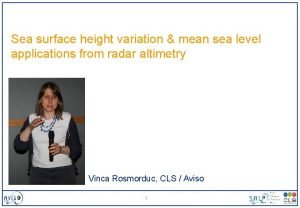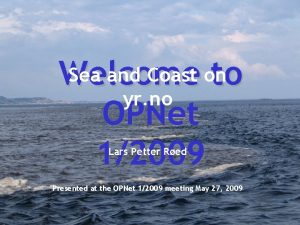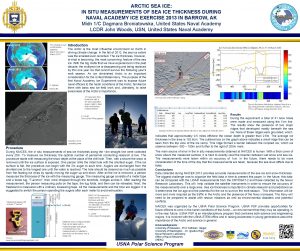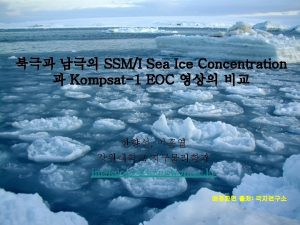Quest for the AntiQuark Sea E 906Sea Quest















































- Slides: 47

Quest for the Anti-Quark Sea: E 906/Sea. Quest Kazutaka Nakahara University of Maryland College Park for the E 906 Collaboration ECT* Conference, Drell-Yan Workshop, Trento, Italy May 2012

Sea. Quest Collaboration ● Los Alamos National Laboratory: ● Abilene Christian University: Donald Isenhower, Tyler Hague, Rusty Towell, Shon Watson ● Academia Sinica: Wen-Chen Chang, Yen-Chu Chen, Shiuan-Hal, Da. Shung Su ● Argonne National Laboratory: John Arrington, Donald F. Geesaman (co-spokesperson), Kawtar Hafidi, Roy Holt, Harold Jackson, David Potterveld, Paul E. Reimer (co-spokesperson), Joshua Rubin Christine Aidala, Gerry Garvey, Mike Leitch, Han Liu, Ming Liu, Pat Mc. Gaughey, Joel Moss, Andrew Puckett ● University of Maryland: Betsy Beise, Kazutaka Nakahara ● University of Michigan: Chiranjib Dutta, Wolfgang Lorenzon, Richard Raymond, Michael Stewart ● National Kaohsiung Normal University: Rurngsheng Guo, Su-Yin Wang ● University of Colorado: Ed(ward) Kinney, Joseph Katich, Po-Ju Lin ● University of New Mexico: Younus Imran ● Fermi National Accelerator Laboratory: Chuck Brown, Dave Christian, Jin-Yuan Wu ● RIKEN: Yoshinori Fukao, Yuji Goto, Atsushi Taketani, Manabu Togawa ● University of Illinois: Bryan Dannowitz, Markus Diefenthaler, Bryan Kerns, Naomi C. R Makins, R. Evan Mc. Clellan, Jen-Chieh Peng ● Rutgers University: Lamiaa El Fassi, Ron Gilman, Ron Ransome, Brian Tice, Ryan Thorpe, Yawei Zhang ● KEK: Shin'ya Sawada ● Tokyo Tech: Shou Miyaska, Kenichi Nakano, Florian Sanftl, Toshi-Aki Shibata ● Ling-Tung University: Ting-Hua Chang ● Yamagata University: Yoshiyuki Miyachi ECT* Conference, Trento, Italy May 2012

• Physics – structure of nucleons and nuclei – Structure of the anti-quark sea – J/ • Experiment/Commissioning Run ECT* Conference, Trento, Italy May 2012

First, a bit of history. . . • First seen in 1970 at BNL/AGS • Proton-uranium collision • Not enough resolution to see resonant structure • Extensively used to probe nucleon structure • Anti-quark structure of nucleons and nuclei? u = d? EMC Effect? • J/ : nucleon gluon distributions, nuclear dependence ECT* Conference, Trento, Italy May 2012

Drell-Yan, DIS, and Parton Distributions DIS and Drell-Yan - both powerful tools in probing parton distributions in nucleons and nuclei - complementary in many respects E 906 Drell-Yan: - Fixed target experiment: LH 2, LD 2, and 3 solid targets - Probe anti-quark structure of nucleons - d/u in the sea – how is the sea generated? - Do parton distributions differ between nucleons and nuclei? - Simultaneous di-muon measurements of J/ probe gluon distributions of nucleons 5 ECT* Conference, Trento, Italy May 2012

Expected Mass Spectrum • How is the nucleon sea generated? Filter out resonances, and focus on DY. Mass spectra from E 866/Nu. Sea ECT* Conference, Trento, Italy May 2012

E 906/Drell-Yan: u = d ? • pp, pd • How is the sea generated? • Drell-Yan is sensitive to antiquarks – specific to the sea • Gluon splitting would suggest symmetry • Gottfried Sum Rule: SG = 1/3 if u = d Charge Symmetry New Muon Collaboration (NMC), Phys. Rev. D 50 (1994) R 1 SG = 0. 235 +/- 0. 026 7 ECT* Conference, Trento, Italy May 2012

Direct Measurements 8 ECT* Conference, Trento, Italy May 2012

Origins of the quark sea? • Various models attempt to explain the cause • Gluon splitting would be symmetric • Valence quark effect? • Non-perturbative models? – Meson cloud model p + n? – Chiral models u d + , d u - ? • Deviation at higher x probe higher x 9 ECT* Conference, Trento, Italy May 2012

E 866 Drell-Yan • Fermilab Meson East Building • 800 Ge. V proton beam • 0. 04 < x < 0. 35 • Uncertainties dominated by statistics (~1% systematic uncertainties in cross section ratio) 10 ECT* Conference, Trento, Italy May 2012

E 906 Drell-Yan • 120 Ge. V proton beam (E 866: 800 Ge. V) – cross section scales as 1/s: 7 x statistics – background scales as s: 7 x luminosity 50 x statistics • Systematic uncertainties ~1% What happens at high x? 11 ECT* Conference, Trento, Italy May 2012

So much for nucleons. . . What about parton distributions in nuclei? Nuclear Modifications ECT* Conference, Trento, Italy May 2012

Nuclear Modification in DIS - Shadowing at low x - Enhancement below x ~0. 3 - Suppression at larger x - Structure functions include both quark and anti-quark contributions - Measured for a broad range of targets (Ann. Rev. Nucl. Part. Phys. , Geesaman, Sato and Thomas) Nuclear Modification in Drell-Yan (E 772) - Drell-Yan accesses the anti-quark component - Binding mediated by pion exchange - Exchanged mesons contain anti-quarks enhancement PRL 64 (1990) 2479 No evidence of anti-quark enhancement in nuclei where did the pions go? 13 ECT* Conference, Trento, Italy May 2012

Nuclear Modification: E 906 Nuclear Targets: Carbon, Iron, Tungsten • Nuclear Modification- complementary with DIS, extends previous Drell-Yan measurements – Extend to x ~ 0. 45 • E 772: 800 Ge. V proton beam • Models must explain both Drell-Yan and DIS. 14 ECT* Conference, Trento, Italy May 2012

• Now filter out DY, and focus on J/ resonance. Mass spectra from E 866/Nu. Sea ECT* Conference, Trento, Italy May 2012

Why J/ ? • Are gluon distributions similar between p and n? • cc deconfinement J/ suppression in QGP – J/ suppression competing against multiple effects: Absorption, CNM induced nuclear dependence Often assumed, but not necessarily fundamental annihilationfusion dimuon pair • qqgluon-gluon ECT* Conference, Trento, Italy May 2012

J/ Production: p-d, p-p • gluon-gluon fusion Lingyan Zhu et al. , PRL, 100 (2008) 062301 (ar. Xiv: 0710. 2344) • Gluon distributions between p and n are very similar • E 866: Upsilon production • E 906: J/ production ECT* Conference, Trento, Italy May 2012

Again, what about bound systems? • cc deconfinement J/ suppression in QGP – J/ suppression during QGP formation competing against multiple effects: absorption, energy loss within nuclei, etc How can we understand these “other processes”? ECT* Conference, Trento, Italy May 2012

J/ Nuclear Dependence Suppression of J/ yield per nucleon ECT* Conference, Trento, Italy May 2012

J/ Nuclear Dependence Suppression of J/ yield per nucleon • absorption ~ x. F=0? – cc dissociation through interaction within nucleus or with comoving secondaries • parton/gluon energy loss? – loss in both initial and final states q, g Cannot account for the suppression remains a mystery ECT* Conference, Trento, Italy May 2012

Can we study some of these effects? Go back to DY for a second. . . ECT* Conference, Trento, Italy May 2012

Partonic Energy Loss: p. A 1/p. A 2 • An understanding of partonic energy loss in both cold and hot nuclear matter is paramount to elucidating RHIC data. • Energy loss through cold nuclear matter • Pre-interaction parton moves through cold nuclear matter and loses energy • Apparent (reconstructed) kinematic values (x 1 or x. F)is shifted • Fit shift in x 1 relative to deuterium (E 906) n Models: • Galvin and Milana • Brodsky and Hoyer • Baier et al. 22 ECT* Conference, Trento, Italy May 2012

• • • • Energy 1/s reveal no energy loss. Fits on loss E 866~data – largerfor at shadowing 120 Ge. V with DIS Correct Sufficient statistics towith remove – X 2 anti-correlates x 1 and x. F shadowing contribution for low x 2 x 1 shadowing contributions at large • Measurements instead ofmust limits – Caveat: A correction be made for shadowing because of x 1—x 2 correlations – E 866 used an empirical correction based on EKS fit to DIS and Drell. Yan. • Better data outside of shadowing region needed E 906 expected uncertainties Shadowing region removed LW 10504 Ene limi rgy lo s ts b ase s uppe Dre d on E r 866 mea ll-Ya sure n men t 23 ECT* Conference, Trento, Italy May 2012

Drell-Yan fixed target experiments at Fermilab • What is the structure of the nucleon? ➡ What is ? ➡ What is the origin of the sea quarks? ➡ What is the high x structure of the proton? • What is the structure of nucleonic matter? ➡ Where are the nuclear pions? ➡ Is anti-shadowing a valence effect? • Do colored partons lose energy in cold nuclear matter? • Sea. Quest: 2012 -2014 ➡ significant increase in physics reach • Beyond Sea. Quest ➡ Polarized Drell-Yan ➡ Pionic Drell-Yan 24

s ine l m Bea t e rg a d. T e x i F Tevatron 800 Ge. V Main Injector 120 Ge. V 25 ECT* Conference, Trento, Italy May 2012

What are we really going to measure? on r I d i l , So agnet ing M Focus absorber n Hadro am dump e and b n 1: o i t a t S array e p o sc Hodo tracking C MWP d 3: n a 2 n Statio ope array king c sc Hodo amber tra h Drift C n 4: o i t a t rray S a e p g sco Hodo be trackin tu Prop eas. M. m Mo gnet) a M (KTe. V 4. 9 m orber s b A n Hadro n Wall) (Iro , and d , 2 H 2 Liquid rgets ta solid 25 m Drawing: T. O’Connor and K. Bailey ECT* Conference, Trento, Italy May 2012

Reduce, Reuse, Recycle • • St. 4 Prop Tubes: Homeland Security via Los Alamos St. 3 & 4 Hodo PMT’s: E-866, HERMES, KTe. V St. 1 & 2 Hodoscopes: HERMES St. 2 & 3 - tracking: E-866 St. 2 Support Structure: KTe. V Target Flasks: E-866 Cables: KTe. V • 2 nd Magnet: KTe. V Analysis Magnet • Hadron Absorber: Fermilab Rail Head? ? ? • Solid Fe Magnet Coils: E-866 SM 3 Magnet • Shielding blocks from old beamline (Fermilab Today) • Solid Fe Magnet Flux Return Iron: E-866 SM 12 Magnet ECT* Conference, Trento, Italy May 2012

E 906 Detector Trigger electronics Scintillator Hodoscopes 28 ECT* Conference, Trento, Italy May 2012

Commissioning Run • Late February 2012 – April 30 th 2012 • First Beam in E 906/Sea. Quest: March 8 th • All systems worked • Some need improvement ECT* Conference, Trento, Italy May 2012

• • BEAM 120 Ge. V/c protons, 19 ns intervals (53 MHz) s ine l am e 1 E 12/s: 5 s spill at 1 minute intervals B get r a T Structure at intermediate frequencies (~1 -1000 Hz) is Fixed important! Tevatron 800 Ge. V Extensive tuning by the Fermilab Accelerator Division throughout the run Main Injector 120 Ge. V 30 ECT* Conference, Trento, Italy May 2012

Target Setup 7 Targets • Liquid H 2 • Empty Flask • Liquid D 2 • “no target” • Fe • C • W • Ca -Motion table -PLC Controlled ECT* Conference, Trento, Italy May 2012

DAQ • CODA (CEBAF Online Data Acquisition) and VME-based Readout Controllers (ROCs = CPUs), TDCs and Scalers • Custom made Time-to-Digital convertor (TDC) cards • Each detector station has a set of dedicated crates/Readout Controllers (ROCs) deadtime detemined by slowest ROC • Common Stop trigger – Both NIM electronics and FPGA • Store event by event in My. SQL analysis and displays • No “zero-suppression” large deadtime ~90 s / TDC Spectra: Prop tube drift time ECT* Conference, Trento, Italy May 2012

Detectors • Hodoscopes – provides triggers + • Wire Chambers/Proportional Tubes - + - • Detectors showed hits consistent with their orientation/geometry. • Final check of their calibration on-going. • New Station 1 and Station 3 - chambers for next run! ECT* Conference, Trento, Italy May 2012

Background Data MC • Understand sources of background between peaks. – for analysis – shielding for next run? ECT* Conference, Trento, Italy May 2012

Mysteries Deadtime: • Each detector station has a set of dedicated crates/Readout Controllers (ROCs) deadtime detemined by slowest ROC – Front-end DAQ deadtime ~0. 7 ms - mostly from TDCs BUT, measured event rate is ~50 -100 Hz (~10 ms deadtime) Where is the bottleneck? “SPLAT” events: • detector stations inundated by high rates - Background? From where? - Beam scraping? - Electronic noise/oscillations? ECT* Conference, Trento, Italy May 2012

Beam Structure - Raw detector rates using a fast pulser trigger intermediate frequency structure of beam intensity - Beam structure causes low duty factor, high effective deadtime, and high singles rates (“Splat”) Hypothesis: Beam tune significantly alters our data-taking rate. low duty factor ~<few ms> intervals between pulses with high instantaneous luminosity ECT* Conference, Trento, Italy May 2012

• Sizable 60 Hz components (and sub-harmonics) Largest: 360 Hz Main Injector power supplies? possibly. . . but. . . there must be more to the story Hypothesis: Beam tune significantly alters our data-taking rate. low duty factor ~<few ms> intervals between pulses with high instantaneous luminosity Fermilab has never done a slow spill extraction from the Main Injector. . . but. . . we need smoother bunches (improve duty factor) to improve event rate ECT* Conference, Trento, Italy May 2012

Background and “Splat” • Large number of hits on all stations from high instantaneous beam rate makes track reconstruction difficult (if not impossible) for those events Again, smooth out beam OR… block the “Splat” somehow ECT* Conference, Trento, Italy May 2012

“Splat” block scheme formulated - “Inhibit card” to veto events with large number of hits - 160 ns integration window – count hodoscope hits (is it greater than threshold? ) ECT* Conference, Trento, Italy May 2012

• Inhibit card results in cleaner hits, higher event rate ECT* Conference, Trento, Italy May 2012

“Splat” block scheme formulated - “Inhibit card” to veto events with large number of hits - 160 ns integration window – count hodoscope hits (is it greater than threshold? ) yes, most of the luminosity is lost to blocking beam tune improvement is best option ECT* Conference, Trento, Italy May 2012

Main Injector Shutdown began (5/1/2012) – 11 months ü 2 E 12 protons/s ü Reconstructable dimuon events seen!! ü Analysis underway ü All subsystems worked – improvements for production run are underway - TDC zero-suppression – significantly improve deadtime Improve beam structure Understand block background Detector upgrades station 1 and station 3 ü Next run to commence - 2013 ECT* Conference, Trento, Italy May 2012


Partonic Energy Loss: E 906 • Energy loss ~ 1/s – larger at 120 Ge. V • Sufficient statistics to remove shadowing contribution for low x 2 • Measurements instead of limits JLab Seminar 6/03/2011 44

EMC Effect Nuclear Modification EMC: hollow circles SLAC: solid circles BCDMS: squares 45 ECT* Conference, Trento, Italy May 2012

Nucleon Structure • 3 valence quarks • Naively, sea generated from gluon splitting • How is the nucleon sea generated? u = d? • Gluon distributions differ between protons/neutrons? ECT* Conference, Trento, Italy May 2012

Proportional Tubes Proportional tube drift time -Drift times of wire chambers and proportional tubes agree with simulation Chamber Gas: P 8 (92%Ar, 8%Methane) + 4% CF 4 Single Tube Cross-Sectional View Ions P 8 + 4% CF 4 ECT* Conference, Trento, Italy May 2012
 What does the sea symbolize in the old man and the sea
What does the sea symbolize in the old man and the sea Led soldiers across hellespont into anatolia goals
Led soldiers across hellespont into anatolia goals Sea stack sea arch
Sea stack sea arch What is asias largest desert
What is asias largest desert Jellyfish
Jellyfish Typiska drag för en novell
Typiska drag för en novell Trög för kemist
Trög för kemist Teckenspråk minoritetsspråk argument
Teckenspråk minoritetsspråk argument Indikation för kejsarsnitt på moderns önskan
Indikation för kejsarsnitt på moderns önskan Autokratiskt ledarskap
Autokratiskt ledarskap Blomman för dagen drog
Blomman för dagen drog Redogör för vad psykologi är
Redogör för vad psykologi är Lek med former i förskolan
Lek med former i förskolan Claes martinsson
Claes martinsson En lathund för arbete med kontinuitetshantering
En lathund för arbete med kontinuitetshantering Mat för idrottare
Mat för idrottare Etik och ledarskap etisk kod för chefer
Etik och ledarskap etisk kod för chefer Svenskt ramverk för digital samverkan
Svenskt ramverk för digital samverkan Datorkunskap för nybörjare
Datorkunskap för nybörjare Plagg i rom
Plagg i rom Orubbliga rättigheter
Orubbliga rättigheter Rita perspektiv
Rita perspektiv Förklara densitet för barn
Förklara densitet för barn Ministerstyre för och nackdelar
Ministerstyre för och nackdelar Bamse för de yngsta
Bamse för de yngsta Vem räknas som jude
Vem räknas som jude Nationell inriktning för artificiell intelligens
Nationell inriktning för artificiell intelligens Sju principer för tillitsbaserad styrning
Sju principer för tillitsbaserad styrning Nyckelkompetenser för livslångt lärande
Nyckelkompetenser för livslångt lärande Romarriket tidslinje
Romarriket tidslinje Exempel på lyrik
Exempel på lyrik Mästar lärling modellen
Mästar lärling modellen Stål för stötfångarsystem
Stål för stötfångarsystem Texter för hinduer tantra
Texter för hinduer tantra Adressändring ideell förening
Adressändring ideell förening Verktyg för automatisering av utbetalningar
Verktyg för automatisering av utbetalningar Aktiv exspektans
Aktiv exspektans Kyssande vind analys
Kyssande vind analys Tack för att ni lyssnade bild
Tack för att ni lyssnade bild Strategi för svensk viltförvaltning
Strategi för svensk viltförvaltning Varians
Varians Informationskartläggning
Informationskartläggning Tack för att ni har lyssnat
Tack för att ni har lyssnat Klassificeringsstruktur för kommunala verksamheter
Klassificeringsstruktur för kommunala verksamheter Returpilarna
Returpilarna Cks
Cks Läkarutlåtande för livränta
Läkarutlåtande för livränta Påbyggnader för flakfordon
Påbyggnader för flakfordon
